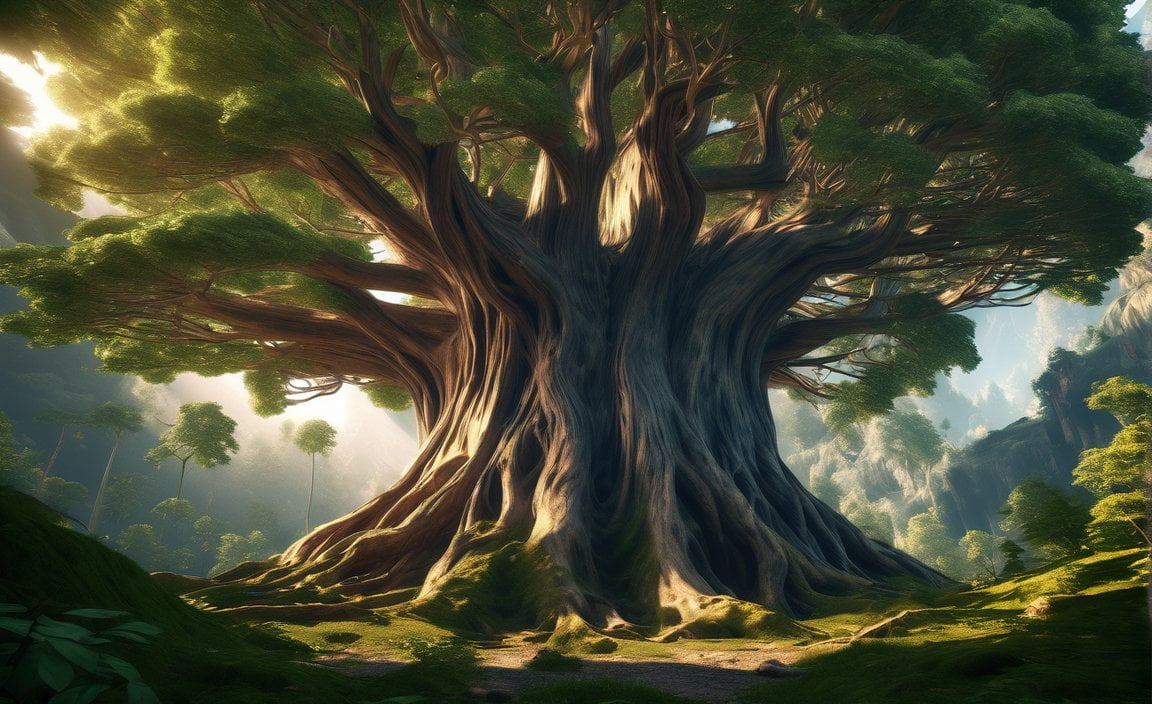Get ready to be amazed as we delve into the enchanting world of trees in this article titled [Discover 5 Astonishing Tree Facts]. Today, we will uncover five intriguing and mind-boggling facts about these magnificent beings that will leave you in awe of their extraordinary abilities and significance in our lives. From their astonishing adaptability to their crucial role in combating climate change, let’s embark on a journey of discovery and appreciation for the wonders of trees.
Key Takeaways:
- Trees cover approximately 30% of the Earth’s land surface.
- There are over 60,000 different species of trees in the world.
- The tallest tree in the world, named Hyperion, is a coast redwood and measures 379.7 feet (115.7 meters) tall.
- The oldest tree in the world, named Methuselah, is a bristlecone pine and is over 4,800 years old.
- One large tree can provide enough oxygen for four people to breathe.
- Trees can lift up to 100 gallons of water out of the ground and discharge it into the air in one day.
- Trees can help reduce energy costs and block noise.
- Trees have the ability to communicate and defend themselves against attacking insects.
- Some trees, like the seeds of the moon tree, have been to the moon.
5 Amazing Facts About Trees

Fact 1: Trees are Earth’s Natural Guardians
Did you know that trees cover approximately 30% of the Earth’s land surface? That’s right, these towering giants play a critical role in sustaining our planet’s ecosystems. They absorb harmful carbon dioxide and release oxygen, allowing us to breathe fresh air. In fact, one large tree can provide enough oxygen for four people to breathe! So next time you take a deep breath of crisp, clean air, remember to thank the trees.
Fact 2: Trees Are Astonishingly Diverse
Nature never fails to surprise us, and the world of trees is no exception. With over 60,000 different species of trees in the world, each one comes with its own unique characteristics and beauty. From majestic oak trees to elegant cherry blossoms, there’s a tree to capture every heart and imagination. So take a moment to appreciate the astonishing diversity that resides within the great forest.
Fact 3: Trees Hold Astounding Records
When it comes to being extraordinary, trees take the cake. The tallest tree in the world, known as Hyperion, stands at a mind-boggling height of 379.7 feet (115.7 meters). Just imagine the perspective from up there! On the other hand, the oldest tree in the world, named Methuselah, has witnessed over 4,800 years of history. These ancient giants remind us of the incredible longevity and resilience of trees.
Fact 4: Trees Perform Hidden Marvels
While we often appreciate the aesthetic beauty of trees, their hidden marvels are equally astonishing. Did you know that trees can lift up to 100 gallons of water out of the ground and discharge it into the air in a single day? Talk about pumping iron! In addition, trees have the remarkable ability to communicate and defend themselves against attacking insects. They emit chemical signals and release substances that repel or attract certain creatures, showcasing nature’s incredible strategies for survival.
Fact 5: Trees Have a Cosmic Connection
Believe it or not, some trees have traveled beyond the realms of our planet. Seeds from trees like the Sycamore and the Loblolly Pine were taken aboard space missions and germinated in microgravity. These trees, known as moon trees, have a celestial origin and serve as a reminder of humanity’s interstellar adventures.
In conclusion, trees are not merely green adornments of the Earth’s surface. They are magnificent, diverse, and awe-inspiring living beings that deserve our utmost respect and admiration. From their role in maintaining the delicate balance of our environment to their astonishing records and hidden marvels, trees continue to amaze us. So let’s celebrate the wonders of trees and ensure their preservation for generations to come. Let us be inspired by these 5 amazing facts about trees and embrace their importance in our lives and our planet.
Here are some interesting links that you might want to explore:
- 5 facts about light energy: Curious to learn more about light energy? Click here to discover five fascinating facts!
- 5 lines on importance of water in sanskrit: Dive into the significance of water in Sanskrit with these five powerful lines. Click here to explore!
- 5 meals a day planner: Looking for a convenient meal planning solution? Check out this five meals a day planner to simplify your routine!
- 5 reasons to get a dog: Want to know why getting a dog is a great idea? Click here to explore five compelling reasons to welcome a furry friend into your life!
Start clicking and enjoy the exploration!
Trees Communicate Through an Underground Network
Trees are not just beautiful and majestic; they are also remarkable organisms that play a vital role in our environment. While we may admire their towering heights and lush foliage, there is so much more to trees than meets the eye. Did you know that trees have their own unique way of communicating with each other? In fact, they have a fascinating underground network that allows them to share nutrients and information. Let’s delve into the astonishing world of tree communication and discover how trees connect with each other through an underground network.
The Wood-Wide Web: Trees’ Underground Communication Network
Trees have a secret language that exists beneath the surface. They form a network of underground fungi called mycorrhizal, which acts as a conduit for communication and nutrient exchange between trees. This network is often referred to as the “wood-wide web,” and it plays a crucial role in facilitating the flow of information and resources among trees in a forest ecosystem.
Communication and Cooperation Among Trees
Just like humans, trees have a social life. Through the underground mycorrhizal network, trees are able to communicate and share key resources with one another. They send chemical signals and messages through the network, alerting nearby trees of potential threats, such as insect infestations or other dangers. This interconnected community of trees creates a complex and cooperative system that benefits the entire forest.
Nutrient Sharing and Support
Trees rely on the underground network to share valuable nutrients with each other. In times of need, healthier and more mature trees can transfer nutrients to younger or weaker trees that may be struggling. This collaborative act ensures the survival and growth of the entire forest ecosystem. It’s a true display of nature’s ability to work together for the greater good.
Warnings and Defense Mechanisms
The underground network not only facilitates nutrient sharing but also serves as a warning system for trees. When a tree detects the presence of harmful insects or pathogens, it can release chemical signals through the mycorrhizal network to alert neighboring trees. These warnings prompt the neighboring trees to boost their own defense mechanisms, such as producing chemicals that repel insects or strengthen their resistance to diseases. It’s a remarkable example of how trees protect and support each other.
Maintaining Balance and Sustaining Life
The communication network between trees plays a crucial role in maintaining the balance of forest ecosystems. It allows trees to respond collectively to changes in environmental conditions, ensuring the survival of the entire community. By sharing resources, warnings, and defense mechanisms, trees can adapt and thrive in their natural habitats. They are a testament to the intricate interdependence of all living organisms in an ecosystem.
Key Takeaways:

- Trees have an underground network called mycorrhizal, also known as the “wood-wide web,” which enables them to communicate and share nutrients.
- Through the mycorrhizal network, trees send chemical signals and warnings to neighboring trees, alerting them of potential threats.
- The network allows healthier and more mature trees to support weaker or younger trees by transferring nutrients.
- Trees in a forest ecosystem cooperate and work together for the benefit of the entire community.
- The communication network helps trees maintain balance, adapt to environmental changes, and sustain life in their habitats.
Sources:
– Utopia – 10 Facts About Trees: How They Feel & Communicate
– BBC Science Focus Magazine – Can the Wood-Wide Web really help trees talk to each other?
Trees have healing properties
Did you know that trees are not only beautiful and majestic, but they also have incredible healing properties? From providing medicinal compounds to improving our overall well-being, trees play a vital role in healing both ourselves and the planet.
Here are 5 astonishing facts about trees and their healing properties:
1. Forests as a rich source of medicinal compounds
Forests have been recognized as a rich source of medicinal compounds for thousands of years. In fact, 25% of all medicines are derived from compounds found in trees[^1]. The bark, leaves, and extracts from various tree species have been used in traditional medicine and have healing properties that have been valued by indigenous cultures for centuries[^1].
2. Tree aerosols with anti-cancer properties
Did you know that tree aerosols have been found to have anti-cancer properties? These aerosols, released by trees, can potentially help in the fight against cancer[^2]. Research has shown that trees, particularly certain species like the yew tree, produce compounds that are used in cancer treatment drugs, such as Taxol[^2].
3. Stress reduction and improved cognition
Spending time in nature, surrounded by trees, has been proven to lower stress levels and improve cognition[^3]. The Harvard T.H. Chan School of Public Health has highlighted the health benefits of trees, showing that they have a positive impact on our mental well-being and can even boost longevity[^3]. So the next time you’re feeling stressed, take a walk in the woods and let the healing power of trees soothe your mind.
4. Environmental contributions
Trees not only benefit our health but also play a crucial role in the environment. They help filter air and water, control soil erosion, and provide habitats for various species of wildlife[^4]. Trees also contribute to the overall well-being of communities, raising property values and creating a sense of harmony and beauty in urban areas[^4]. By protecting and valuing trees, we can ensure a healthier environment for future generations.
5. A reminder of humanity’s interstellar adventures
In a fascinating intersection of science and nature, tree seeds have been taken on space missions and germinated in microgravity, resulting in what are known as “moon trees”[^1]. These special trees serve as a reminder of humanity’s interstellar adventures and the enduring nature of trees, even in the most extreme environments.
Key Takeaways:
- Forests are a rich source of medicinal compounds, with 25% of all medicines derived from trees[^1].
- Tree aerosols have anti-cancer properties, potentially aiding in cancer treatment[^2].
- Spending time in nature surrounded by trees can lower stress levels and improve cognition[^3].
- Trees play a vital role in the environment by filtering air and water, controlling soil erosion, and providing habitats for wildlife[^4].
- “Moon trees” serve as a reminder of humanity’s interstellar adventures and the resilience of trees[^1].
Sources:
– [^1]: The Healing Power of Trees | Psychologies
– [^2]: The Health Benefits of Trees | News | Harvard T.H. Chan School of Public Health
Trees have an extraordinary capacity to heal, both ourselves and the planet. From their medicinal properties to their environmental contributions, trees truly have healing properties that should be cherished and protected. So next time you admire a tree, remember the amazing ways in which it contributes to our health and well-being.
Trees play a crucial role in fighting climate change
Trees are not just beautiful and majestic organisms; they also have a vital role in combating climate change and preserving our planet. Let’s explore some astonishing facts about trees that highlight their significance in the fight against climate change.
Fact 1: Trees are powerful carbon sinks
One of the most crucial ways trees combat climate change is by acting as natural carbon sinks. Through the process of photosynthesis, trees absorb carbon dioxide from the atmosphere and store it in their trunks, branches, and leaves. This helps to mitigate the effects of climate change, as excess carbon dioxide is a major contributor to global warming. Trees play a crucial role in reducing greenhouse gas emissions and preserving the balance of our ecosystem[^5^].
Fact 2: Tree planting initiatives are essential but not a standalone solution
While tree planting initiatives are critical in the fight against climate change, it’s important to recognize that they are not a standalone solution. Planting trees alone cannot solve the climate crisis. It is equally important to address the root cause by reducing greenhouse gas emissions and transitioning to cleaner, more sustainable energy sources. However, planting trees thoughtfully and considering factors such as soil carbon can still have positive impacts[^2^].
Fact 3: Trees provide essential ecosystem support
Trees form the backbone of complex ecosystems, providing a myriad of ecological benefits. They contribute to soil stabilization, water purification, and nutrient cycling. By doing so, trees play a crucial role in maintaining ecosystem balance and supporting biodiversity. Protecting and planting trees is vital for the overall health and well-being of our planet[^5^].
Fact 4: Trees help regulate rainfall patterns
Trees play a significant role in regulating rainfall patterns. By maintaining moisture levels in the atmosphere, trees help influence regional climate patterns and precipitation rates. This explains why deforestation often leads to changes in local weather conditions and can result in droughts or floods. Preserving and planting trees is essential for ensuring a stable and balanced climate[^1^].
Fact 5: Trees contribute to overall well-being
Being in nature and surrounded by trees has numerous psychological and physical health benefits. Spending time in forested areas can lower stress levels, improve mood, and enhance overall well-being. Trees also provide shade and help regulate temperatures in urban areas, making them crucial in the face of rising temperatures due to climate change. Recognizing and valuing the presence of trees is essential for our own health and the health of the planet[^5^].
Key Takeaways:
– Trees act as carbon sinks, absorbing carbon dioxide from the atmosphere and storing it, helping to mitigate climate change[^5^].
– Tree planting initiatives are beneficial but should not be viewed as a standalone solution to the climate crisis[^2^].
– Trees provide essential ecosystem support, contributing to soil stabilization, water purification, and nutrient cycling[^5^].
– Trees play a significant role in regulating rainfall patterns and influencing climate stability[^1^].
– Being in nature and surrounded by trees has numerous psychological and physical health benefits[^5^].
Sources:
[^1^]: Science in the News – Exploring The Underground Network of Trees
[^2^]: Science News: Controversy Surrounding Tree Planting in Fighting Climate Change
[^5^]: The Health Benefits of Trees – Harvard T.H. Chan School of Public Health
FAQ
Q1: Are trees really the ultimate multitaskers?
A1: Yes, trees are incredible multitaskers. They purify the air, provide shade, and generate oxygen through photosynthesis.
Q2: How long can some trees live?
A2: Some trees can live for thousands of years. Ancient bristlecone pines and yew trees, for example, can live for over 5,000 years.
Q3: What is the tallest tree ever recorded?
A3: The tallest tree ever recorded was a coast redwood that stood at an astounding height of 379.7 feet.
Q4: How do trees communicate with each other?
A4: Trees have their own unique way of communicating through a network of underground fungi called mycorrhizal. This network allows them to share nutrients and information with each other.
Q5: What are some of the health benefits of trees?
A5: Spending time in nature and being surrounded by trees has been shown to have numerous psychological and physical health benefits. It can lower stress levels, improve mood, and enhance overall well-being.
- Unlocking Francis Alexander Shields’ Finance Empire: A Comprehensive Biography - July 12, 2025
- Unveiling Francis Alexander Shields: A Business Legacy - July 12, 2025
- Francis Alexander Shields’ Business Career: A Comprehensive Overview - July 12, 2025

![[Facts About Life on Land]: Unveiling the Wonders of Terrestrial Ecosystems facts-about-life-on-land_2](https://www.lolaapp.com/wp-content/uploads/2023/12/facts-about-life-on-land_2-150x150.jpg)













